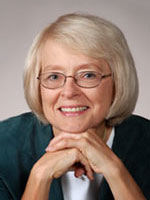

Planning is an interesting challenge for most of us. We either plan too much or plan too little. (And we tend to make fun of those at the opposite end of the spectrum no matter which we are guilty of.) Is one right and the other wrong? And if so, is it planning too little or too much what warrants the boot?
The truth is in the middle, of course. How thoroughly we plan needs to be a function of what it is we are trying to get done. But even that can be a matter of perspective.

If I showed you this photo and said “We need to get to the top of this,” how would you make it happen? Do you even know what you’re dealing with? It’s easy to get deep into the details of things and miss what’s involved at a broader level.
In this particular case, the broader perspective paints a much different picture of what we are trying to do. Getting to “the top of this” is not a matter of running up one of the furrows. Getting to the top of Devils Tower takes climbing skill, specialized gear, and multiple conversations with the folks at the climber registration desk. So the first thing to decide when you think about planning anything should be, “Just what am I looking at here?”
Christmas tasks come to mind on this. We focus on buying the perfect gifts, trimming the tree, decorating the house, getting the outside lights up, remembering to buy eggnog ad nauseam and totally lose track of the basic idea of the season–“joy to the world.”
Planning can make life simpler if you use it at the right times. It can also make life a whole lot more difficult if you get carried away. The best example of the latter that I can point to is a family vacation I took long ago with my then husband, my two sons, (ages 12 and 16 at the time) and my then 11 year-old stepdaughter. The intent was to fly to San Francisco to visit family and see the sights. I planned the whole nine days to a gnat’s eyelash—and insisted on doing exactly what we planned to do exactly when we had predetermined we were going to do it. It was awful, and it was all my sweet little planner-manic fault. What a waste of a good time.
Too little planning isn’t much better though. Traveling without any plan means you’re looking for a motel room when you’re dog tired and wanting to already be in it. (You usually end up with worse accommodations at a much higher price if you do this, too–at least from my road trip experience.) Or maybe you show up in town the week after an event you would have loved to be part of has occurred—that was plastered all over the website if you’d bothered to take a look. It might also mean you don’t have the resources—time, money, or vacation days–to do the dream thing when you finally notice that the opportunity exists.
Finding the right blend of planning and not planning is part of our life-long quest for balance. You need to know what you have to work with and what you are trying to do—to have some idea of where you’re trying to go. That’s the planning. But you also need to leave room for serendipity and magic. That’s non-planning. Remember that as you gear up for your next project. Having the right balance gives much better results.
 A few years ago, I was sending a friend hiking photos on a regular basis because he couldn’t get out on the trail. The hiking opportunities are slim in early spring in the Pacific Northwest. Plus, no matter where you hike, your photos will be mostly shades of gray. So I decided to create a colorful photo. It was Easter Sunday. I’d learned to “tie dye” eggs with food coloring and foil a few years earlier and chose that as my “medium.” That was the “planning” part. I could have just put them on plastic grass in an Easter basket for the photo. But by adding what was available at the moment (the unplanned aspect)–in this case some newly blooming rock cress, the result was much more spectacular.
A few years ago, I was sending a friend hiking photos on a regular basis because he couldn’t get out on the trail. The hiking opportunities are slim in early spring in the Pacific Northwest. Plus, no matter where you hike, your photos will be mostly shades of gray. So I decided to create a colorful photo. It was Easter Sunday. I’d learned to “tie dye” eggs with food coloring and foil a few years earlier and chose that as my “medium.” That was the “planning” part. I could have just put them on plastic grass in an Easter basket for the photo. But by adding what was available at the moment (the unplanned aspect)–in this case some newly blooming rock cress, the result was much more spectacular.
Planning is a tool, not the whole point of the effort. So remember these four things:
* Don’t plan what you can’t control. (It won’t go the way you want anyway.)
* Leave room for magic and last minute detours.
* If the plan becomes a burden, simplify it.
* Plan only for important outcomes; learn to enjoy doing things on the fly.
That should give you the best of both worlds…and you’ll thrive whether your plans are with planners or non-planners.
=======================================================
Mary Lloyd is a speaker and consultant and author of Supercharged Retirement: Ditch the Rocking Chair, Trash the Remote, and Do What You Love. For more, please see her website www.mining-silver.com.

Leave a Reply